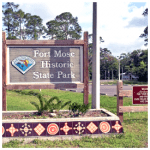
Fort Mose Historic State Park has partnered with Florida Power & Light Company and The Community Foundation for Northeast Florida, with publicity donated by Historic City News, to create a self-guided educational tour experience along the Flight to Freedom Trail. Interactive signage along the 3/4-mile trail will allow the annual reenactment to be experienced year-round.
More than a century before the Emancipation Proclamation, slaves from the British colonies followed the original underground railroad south — not north — to the Spanish colony of La Florida.
Word came aboard ships plying the east coast from Florida through the Carolinas: the governor of Spanish Florida promised freedom to all who would swear allegiance to the Spanish Crown and Catholic faith. The flight to freedom began – through the thickets of the Carolinas, and swamps of Georgia, pursued by overseers and hired bounty men – an underground railroad to their promised land, the Spanish garrison of St. Augustine.
A leader awaited them: Francisco Menendez, brought to the Americas in chains from his native Mandingo, Africa, in the early 1700s, escaped to St. Augustine in 1724, now a captain in the St. Augustine militia, soon to be commander of the first free black settlement in today’s America, Fort Mose.
Responding to this surge of escaped slaves, Spanish Florida’s Governor Manuel Montiano established, in 1738, Gracia Real de Santa Teresa de Mose – Fort Mose (Mo-SAY). It would serve as a northern outpost for the garrison two miles to the south. For Montiano, it would be manned by a fighting force fierce to hold its freedom; for its inhabitants, it would be a new, unshackled life.
Fort Mose became home for more than a hundred freed or fugitive slaves from the British colonies, forming more than 20 households. Together they created a frontier community which drew on a range of African backgrounds blended with Spanish, Native American and English cultural traditions.
Echoing its host city, it became both a defensive garrison and civilian settlement. The first free black settlement was a matter of both religious pressure and military expediency. The powerful Spanish Church had long dictated moral, religious, and social conditions. For slaves, it meant legal rights to full Christian communion, marriage, and parenthood, to personal security, ownership of private property, and the purchase of their own freedom.
Militarily, Spanish Florida’s cedula of freedom would weaken the economy of the British colonies, shifting its labor force from plantation slaves to Spanish soldiers. The night of June 26, 1740, this Spanish policy proved its worth, as a force of 300 regulars, Black militia and Yamasee Indians routed an occupying force during a British siege in the Battle of Bloody Mose.
Discover more from HISTORIC CITY NEWS
Subscribe to get the latest posts sent to your email.




